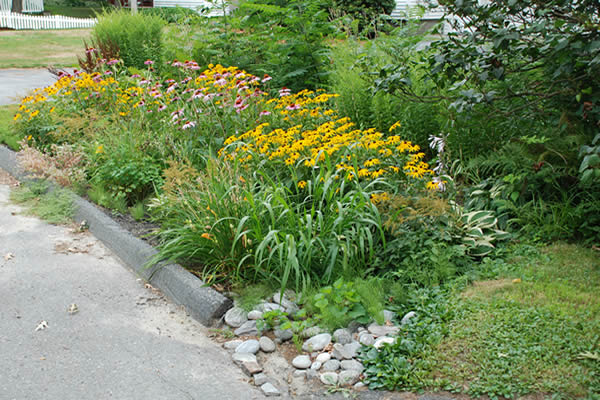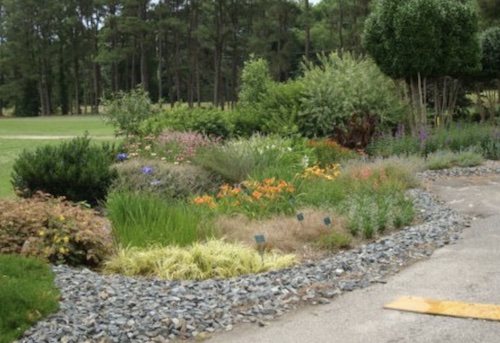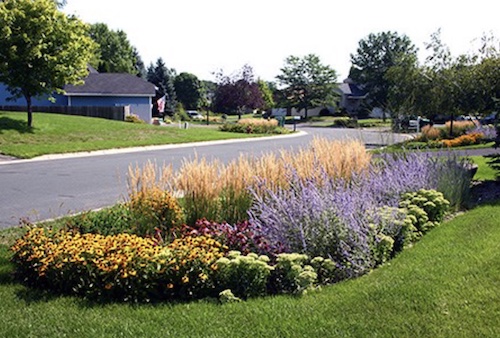Plants for the Rain Garden
by Kathleen Curthoys, Fairfax Master Gardener
Have nothing in your garden that you do not know to be useful or believe to be beautiful, to paraphrase William Morris. Rain gardens are both.

Rain gardens can look attractive
These hard-working garden features can do several jobs: They help solve challenges in the landscape by interrupting the flow of rain water from rooftops, driveways and lawns. Their plants and mulch collect and absorb rain water, reducing runoff. The plants, soil and microorganisms filter pollutants that otherwise would have been washed into storm drains, local streams, rivers and the Chesapeake watershed.
In the rolling landscape of Northern Virginia, rain gardens are beneficial for many homeowners and neighborhoods, preventing or slowing erosion while creating habitats for pollinators and other wildlife and beautifying the area.
Once you’ve designed your rain garden, next comes the most fun part: choosing the plants.
Selecting plants
When planning a rain garden, consider what its size, shape and position will be. Then select specific plants to make the most of this important part of your landscape, enhance the beauty of your surroundings and benefit wildlife such as bees, butterflies and birds.
Look for plants that are hardy in your agricultural zone. Much of Fairfax County is in agricultural zone 7a; surrounding areas also include zones 7b and 8. In terms of physiographic regions, Fairfax County is in the Piedmont region, with areas east of Springfield considered Coastal Plain.
Choose a variety of types of plants that can give visual interest, color and form through the seasons year round. If the rain garden will be a stand-alone space detached from other planting areas, consider plants that will blend cohesively with existing plants in the landscape.

Rain garden with variety
Consider the height and spacing of plants at maturity, and the shade that will be cast by larger plants such as trees and shrubs. Design a layout for the plants to meet their needs for light and shade.
Native plants are a good choice for rain gardens. They are already adapted to local weather and local growing conditions, and they generally need less maintenance than nonnatives. They may thrive without fertilizer or pesticides. They create a welcoming habitat for bees, butterflies and birds as well as beneficial insects. Once they are established after the first year, they may not need to be watered.
Look for plants that can tolerate dry conditions as well as occasional flooding. Drought tolerant plants are recommended by the Northern Virginia Soil and Water Conservation District.
For any plants that are less drought tolerant, plan how you will provide water to them in dry periods, at least as they get established.
Perennials are among the best choices because they establish themselves in the garden and come back year after year. Choose a mix of plants, both woody and herbaceous plants, to vary root depths and create visual interest. Have a mix of heights — tall, medium and short — so the plants can be layered according to landscaping guidelines.
Also think about the shape of the rain garden, which may have slopes to contain water. Consider the likely flow of water out of the garden in the event of heavy rainfall. Clumping grasses may be planted along the edges to help contain the flow and prevent mulch and soil from washing away. Also consider any particular conditions, such as potential runoff from surfaces that are salted in the winter, and whether that will be detrimental to the plants.
As with the rest of your garden, avoid plants that are invasive.
Planting the rain garden
Do a soil test in the rain garden area, if needed, to determine whether the soil needs to be amended.
Use plants rather than seeds, which may wash away before they have an opportunity to grow their roots and take hold in the soil.
Space the plants so their tops will grow close together and minimize growth of weeds, being careful not to overcrowd them. If you plant trees, consider placing them at the perimeter of the area.
Extend plantings beyond the perimeter of the rain garden if that will help the garden blend in with the rest of the landscape.
Maintenance
As plants get established during their first growing season, it may be necessary to water them if there is an extended dry period. The recommended amount is 1 inch of water per week. If the rain garden is a distance from a water source, consider ahead of time how the plants can be watered.
Keep the rain garden mulched, once or twice a year, to help prevent weeds and to retain moisture for the plants.
Here are a few native plants suggested for Northern Virginia rain gardens. This list is not comprehensive; many more plants may be well suited to rain gardens.
Deciduous shrubs, spring blooming: Shrubs that tolerate flooding in the rain garden include Red Chokeberry (Aronia arbutifolia), which tolerates both wet and dry soil. Black Chokeberry (Aronia melanocarpa) also will withstand moist or dry soil. Shrubs that tolerate some clay in the soil include Canada Serviceberry (Amelanchier canadensis), Arrowwood Viburnum (Viburnum dentatum) and Spicebush (Lindera benzoin), which stands up to drought. All these shrubs have white or pale-colored blooms and they attract birds. They may also attract butterflies, particularly the Arrowwood Viburnum and Spicebush.
 Deciduous shrubs, summer blooming: Buttonbush (Cephalanthus occidentalis) tolerates flooding, as does Virginia Sweetspire (Itea virginica). Buttonbush has white ball-like flowers, winter interest and attracts hummingbirds, butterflies and beneficial insects. Sweetspire produces distinctive drooping white blooms. Winterberry (Ilex verticillata) tolerates both moist soil and drought, and female plants have bright red berries in fall and winter. All these shrubs attract birds.
Deciduous shrubs, summer blooming: Buttonbush (Cephalanthus occidentalis) tolerates flooding, as does Virginia Sweetspire (Itea virginica). Buttonbush has white ball-like flowers, winter interest and attracts hummingbirds, butterflies and beneficial insects. Sweetspire produces distinctive drooping white blooms. Winterberry (Ilex verticillata) tolerates both moist soil and drought, and female plants have bright red berries in fall and winter. All these shrubs attract birds.
Perennials, spring blooming: Wild Blue Phlox (Phlox divaricata) does well in moist soil but can stand drought once it is established. This adaptable, low-growing phlox attracts butterflies.
Perennials, summer blooming: Those that can tolerate drought include Black-Eyed Susan (Rudbeckia hirta), New England Aster (Symphyotrichum novae-angliae), Rough-Stemmed Goldenrod (Solidago rugosa) and Butterfly Weed (Asclepias tuberosa), which doesn’t mind shallow, rocky soil.
Among the versatile perennials that can take dry or wet soil are Blue Mistflower (Conoclinium coelestinum), Joe-Pye Weed (Eutrochium purpureum), Ox-Eye Sunflower (Heliopsis helianthoides), deer-resistant Wild Bergamot (Monarda fistulosa) and Purple Coneflower (Echinacea purpurea), which is native to the Midwest but it is commonly cultivated in the Mid-Atlantic region and proves popular with local pollinators.
Other perennials prefer moist or wet soil, such as Swamp Milkweed (Asclepias incarnata), Marsh Mallow (Hibiscus moscheutos), Cardinal Flower (Lobelia cardinalis), deer resistant Bee Balm (Monarda didyma) and Blue Vervain (Verbena hastata). Deer-resistant Butterfly Weed (Asclepias tuberosa) is a host for the Monarch butterfly.
Northern Blue Flag Iris (Iris versicolor) does well in marshy areas, water gardens and the edges of ponds, so it will tolerate flooding in the rain garden.
All these perennials are known for attracting pollinators such as bees, butterflies and birds.
Grasses and ferns: Grasses can be useful for edging the rain garden and creating a border. Grasses that tolerate both dry and wet conditions include Broomsedge (Andropogon virginicus), Switchgrass (Panicum virgatum) and Indian Grass (Sorghastrum nutans). All of these flower in summer and attract butterflies and birds.
Ferns such as Cinnamon Fern (Osmundastrum cinnamomeum) and Royal Fern (Osmunda regalis) like moist or wet soil. These two can tolerate drought in the shade. They both thrive in part to full shade.
Resources
• Rain Garden Design and Construction, A Northern Virginia Homeowner’s Guide, Northern Virginia
Soil and Water Conservation District
• Plant NOVA Natives, Northern Virginia Native Plant Society
• Native Plants for Wildlife Habitat and Conservation Landscaping in the Chesapeake Bay Watershed,
U.S. Fish and Wildlife Service
• Rain Garden Plants, Mike Andruczyk and Laurie Fox, Virginia Cooperative Extension
• Stormwater Management for Homeowners Fact Sheet 5, Publication SPES-13P, Virginia Cooperative
Extension
• Rain Garden Plant Selection, North Carolina State University Cooperative Extension Service